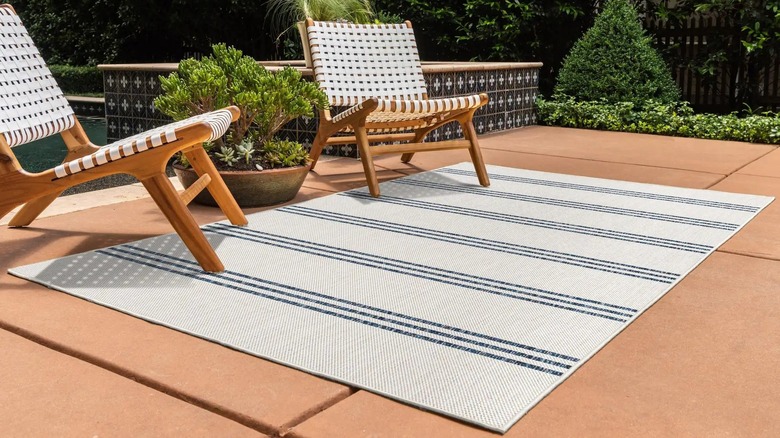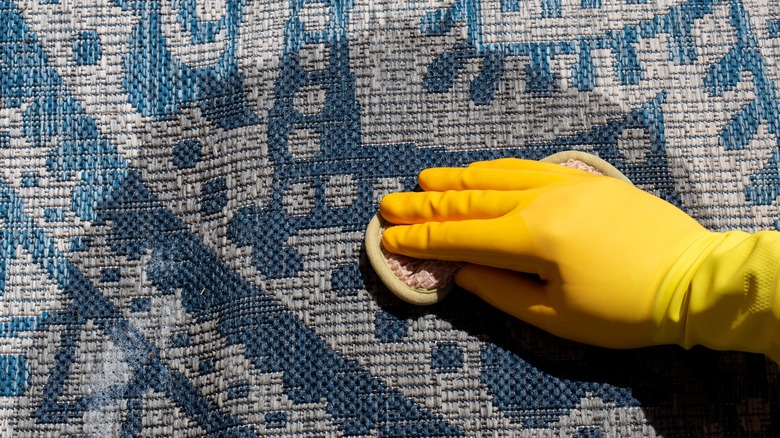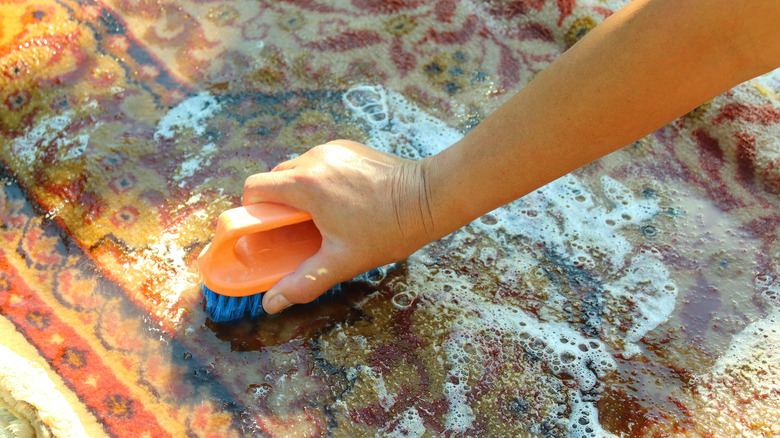Here's How Often You Should Clean Your Outdoor Rugs
When it comes to rolling out fashion and function beyond the front door, outdoor rugs are hard to beat. Whether they are used to protect flooring, cover damage, or bring color and style to an outdoor living space, their versatility perfectly complements their durability. For most homeowners that means buying an outdoor rug or welcome mat, placing it in a prime spot, and letting it lie — all year long. Therein lies the problem. While outdoor rugs don't need to be cleaned as often as their indoor counterparts, they can't be neglected indefinitely. Generally, a thorough cleaning should happen once a month, but this can vary depending on rug placement and your family's traffic patterns.
When was the last time you took a good look at your outdoor rug? If it has been a while, you aren't alone. For many homeowners, the same floor covering they bought to define their outdoor living space quickly morphs into an inconspicuous addition. What's more, if an outdoor rug is colored, patterned, or textured, it may be difficult to truly discern how dirty it really is. Soda spills, ketchup smears, burger juice, and not to mention daily deposits of dust, dirt, and grime, can easily camouflage on a busy rug or doormat. Fortunately, cleaning and maintaining an outdoor rug doesn't take a ton of time or effort. The key is to schedule regular care before a little mess becomes a large problem.
Timing light cleanings
There are several factors to consider when choosing the right doormat or outdoor rug, and chief among them is construction. Most outdoor rugs and mats are made of heavy-duty, water- and stain-resistant synthetic materials designed to withstand whatever your kids and Mother Nature throws at them. If this includes sticky juice or hot dog grease, tackle the mess while it's fresh. Don't wait to clean protein stains; rather, as soon as you can, gently blot spills with a clean rag. If marks remain spot treat them with a paste of hydrogen peroxide and baking soda. For large spills, clean the rug with a mixture of dish soap and warm water, then rinse the rug or mat by spraying with a garden hose.
If your rug or mat sees a lot of action or it's been a particularly muddy season, give it a good shake at the end of each day. You may need an extra set of hands if you are cleaning a larger area rug; otherwise, drape it over a fence, deck railing, or tree branch and strike it with a rake or tennis racket. Doing so will dislodge any dust, debris, or crumbs that may have accumulated below the surface. For rugs or mats placed near trees, consider sweeping, vacuuming, or using a leaf blower on both sides once a week. Not only will this prevent foliage from piling up on your outdoor floor coverings, but it also eliminates pollen and bird droppings that may have fallen.
When to schedule deep cleans
At the very least, outdoor rugs and doormats should be treated to a thorough cleaning at the end of each season. However, if you host a lot of get-togethers and your outdoor floor coverings regularly serve as a buffet catch-all, give them a deep clean once a month. The easiest way to do so is in a washing machine. However, before tossing a dirty outdoor rug or doormat into your washer it is vital to first read the care instructions printed on its label.
If your mat or rug's tag is missing, err on the side of caution by cleaning it by hand. You can safely scrub outdoor floor coverings by using an environmentally-friendly mixture of baking soda and white vinegar. Simply sprinkle baking soda over the entire surface of the rug then spritz with vinegar using a spray bottle. Allow the natural cleaner to sit for several minutes before thoroughly rinsing the rug with a garden hose. For tough stains, or if you have allowed mold or mildew to grow on the rug's surface for a couple of months, apply diluted dish soap to the affected area and gently scrub with a soft-bristle brush. Rinse the rug until the water runs clear. Next, dry it in a sunny area on a flat surface or hang it straight on a clothesline using clothespins. Doing so will help preserve your rug's shape.


